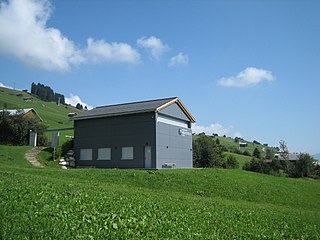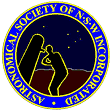
Amateur astronomy is a hobby where participants enjoy observing or imaging celestial objects in the sky using the unaided eye, binoculars, or telescopes. Even though scientific research may not be their primary goal, some amateur astronomers make contributions in doing citizen science, such as by monitoring variable stars, double stars, sunspots, or occultations of stars by the Moon or asteroids, or by discovering transient astronomical events, such as comets, galactic novae or supernovae in other galaxies.
Alexander Forbes Irvine Forbes was a South African astronomer, architect and artist, best known for his discovery of periodic comets.

Thomas Joel Bopp was an American amateur astronomer. In 1995, he discovered comet Hale–Bopp; Alan Hale discovered it independently at almost the same time, and it was thus named after both of them. At the time of the comet discovery he was a manager at a construction materials factory and an amateur astronomer. On the night of July 22, Bopp was observing the sky with friends in the Arizona desert when he made the discovery. It was the first comet he had observed and he was using a borrowed, home-built telescope.
The Astronomical Society of Southern Africa (ASSA), formed in 1922, is a widespread body consisting of both amateur and professional astronomers. There are eight autonomous centres throughout Southern Africa.

A robotic telescope is an astronomical telescope and detector system that makes observations without the intervention of a human. In astronomical disciplines, a telescope qualifies as robotic if it makes those observations without being operated by a human, even if a human has to initiate the observations at the beginning of the night or end them in the morning. It may have software agents using artificial intelligence that assist in various ways such as automatic scheduling. A robotic telescope is distinct from a remote telescope, though an instrument can be both robotic and remote.

Siding Spring Observatory near Coonabarabran, New South Wales, Australia, part of the Research School of Astronomy & Astrophysics (RSAA) at the Australian National University (ANU), incorporates the Anglo-Australian Telescope along with a collection of other telescopes owned by the Australian National University, the University of New South Wales, and other institutions. The observatory is situated 1,165 metres (3,822 ft) above sea level in the Warrumbungle National Park on Mount Woorat, also known as Siding Spring Mountain. Siding Spring Observatory is owned by the Australian National University (ANU) and is part of the Mount Stromlo and Siding Spring Observatories research school.

The Perth Observatory is the name of two astronomical observatories located in Western Australia (WA). In 1896, the original observatory was founded in West Perth on Mount Eliza overlooking the city of Perth. Due to the city's expansion, the observatory moved to Bickley in 1965. The new Perth Observatory is sometimes referred to as Bickley Observatory.

Mills Observatory is the first purpose-built public astronomical observatory in the UK, located in Dundee, Scotland. Built in 1935, the observatory is classically styled in sandstone and has a distinctive 7 m dome, which houses a Victorian refracting telescope, a small planetarium, and display areas. The dome is one of two made from papier-mâché to survive in the UK, the other being at the Godlee Observatory.
William Ashley Bradfield was a New Zealand-born Australian amateur astronomer, notable as a prolific amateur discoverer of comets. He gained a world record by discovering 18 comets, all of which bear his name as the sole discoverer.

The Heights Observatory is an Astronomical Observatory at The Heights School in Modbury Heights, Adelaide, South Australia.

J A Jones Hoober Observatory is a privately owned observatory located in South Yorkshire, England near to the villages of Hoober and Wentworth, 4 miles (6.4 km) North-northwest of Rotherham. It can be found about 300 metres (0.19 mi) east of Hoober Stand. The observatory is owned and operated by Mexborough & Swinton Astronomical Society (NPO).

The Mirasteilas Observatory is an astronomical observatory in Falera in the canton of Grisons in Switzerland. With its 90-centimeter telescope it is the largest publicly accessible observatory in Switzerland.

Sutherland Astronomical Society Incorporated (SASI) is an amateur astronomical society based in the Sutherland Shire, in the southern suburbs of Sydney, Australia. It operates the Green Point Observatory, it is one of the two founding organizations of the National Australian Convention of Amateur Astronomers, and its members have discovered two comets and two novae.

The Astronomical Society of New South Wales (ASNSW) is an amateur astronomy club in the state of New South Wales, Australia. Founded in 1954, the society currently has over 400 members.

The Astronomical Society of Victoria (ASV) is an amateur astronomy club in the state of Victoria, Australia. It was founded in 1922, making it one of the oldest such clubs in the country, and with some 1500 members it claims to be one of the largest amateur astronomy organisations in the southern hemisphere. Membership is open to all with an interest in astronomy, and the society caters for people with a wide range of ages, backgrounds, abilities and interests.
The Astronomy Centre, also known as the Amateur Astronomy Centre, is an astronomical observatory located in northern England which is run by experienced amateur astronomers and is open to the public at certain times.

The Linden Observatory Complex is a heritage-listed former observatory and manufacture of optical precision implements and now residence, museum, observatory, education facility and meeting venue located at 91 – 111 Glossop Road, Linden, City of Blue Mountains, New South Wales, Australia. It was designed and built by Ken Beames from 1938 to 1948. It is also known as K Beames Engineering Co. The property is owned by the Linden Observatory Trust. It was added to the New South Wales State Heritage Register on 5 March 2010.
John Caister "Jack" Bennett, was a South African civil servant and amateur astronomer. His mother was British and his father was from Tasmania. He attended school in Ficksburg and began to work in public service after graduating in 1934, initially in the forestry administration in Elgin before moving to the administration of Transvaal Province in Pretoria. During World War II he served as a soldier in South Africa, Egypt and Italy. In 1974 he retired from the public service. From 1985 he began to suffer from arthritis and soon afterwards his health deteriorated so much that he had to sell his house in Pretoria's Riviera neighborhood and move into a nursing home. He died on 30 May 1990 at the age of 76.
Tenagra Observatory and Tenagra Observatory II are astronomical observatories in Cottage Grove, Oregon and Arizona. The observatories house heavily automated robotic telescopes.













